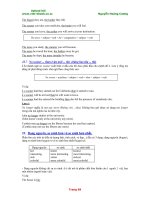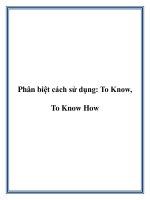Giáo trình Toefl - Cách sử dụng to know và to know how
Bạn đang xem bản rút gọn của tài liệu. Xem và tải ngay bản đầy đủ của tài liệu tại đây (1.06 MB, 12 trang )
Upload bởi
www.viet-ebook.co.cc Nguyễn Hoàng Cương
Trang 93
động từ động từ
38. Cách sử dụng to know và to know how
N hũng công thức sau đây liên quan tới cách sử dụng động từ know. Know how luôn được sử dụng
để chỉ một ai đó có kỹ năng hay khả năng làm việc gì. Vì vây, nó thường được đi theo bởi một
động từ, và khi đó, động từ phải ở dạng nguyên thể có to.
Subject + know how to do smth : biết cách làm gì như thế nào.
Tuy nhiên sau to know còn có thể là một danh từ, một ngữ giới từ hoặc một câu hoàn chỉnh.
danh từ
subject + know + ngữ giới từ
câu
Tuy nhiên đằng sau to know how vẫn có thể dùng 1 mệnh đề hoàn chỉnh để chỉ khả năng giải
quyết hoặc việc bắt buộc phải làm.
Ví dụ:
At a glance, he knew how
he could solve this math problem.
Seeing the weather map, the pilot knew how
he had to fly at which line.
Một số thí dụ:
Bill knows how
to play tennis well.
Maggie and her sister know how
to prepare Chinese food.
Do you know how
to get to Jerry’s house from here ?
Jason knew
the answer to the teacher’s question.
N o one knows
about Roy’s accepting the new position.
I didn’t know
that you were going to France.
39. Mệnh đề nhượng bộ
Là loại mệnh đề diễn đạt 2 ý trái ngược trong cùng một câu thông qua một số thành ngữ.
39.1 Despite / in spite of (mặc dù)
Đằng sau 2 thành ngữ này chỉ được phép sử dụng một ngữ danh từ, không được sử dụng một câu
hoàn chỉnh.
In spite of
+ ngữ danh từ
Despite
Ví dụ:
Despite
his physical handicap, he has become a successful businessman.
In spite of
his physical handicap, he has become a successful businessman.
Jane will be admitted to the university despite
her bad grades.
Jane will be admitted to the university in spite of
her bad grades.
Upload bởi
www.viet-ebook.co.cc Nguyễn Hoàng Cương
Trang 94
39.2 although, even though, though
Đằng sau 3 thành ngữ này phải dùng một câu hoàn chỉnh không được dùng một ngữ danh từ.
Although
even though + Subject + Verb + (complement) ...
though
Ví dụ:
Although
he has a physical handicap, he has become a successful businessman.
Jane will be admitted to the university even though
she has a bad grades.
Lưu ý
: N ếu though đứng ở cuối câu, tách ra khỏi câu bằng 1 dấu phNy. Khi nói hơi dừng lại một
chút, lúc đó nó tương đương với nghĩa “ tuy nhiên” (however).
Ví dụ:
He promised to call me, but till now I haven’t received any call from him, though
.
Một số thí dụ bổ trợ
In spite of
the bad weather, we are going to have a picnic.
The child ate the cookie even though
his mother had told him not to.
Although
the weather was very bad, we had a picnic.
The committee voted to ratify the amendment despite
the objections.
Though
he had not finished the paper, he went to sleep.
She attended the class although
she did not feel alert.
40. Những động từ dễ gây nhầm lẫn
Đó là những động từ trong bảng sau:
N ội động từ
rise
lie
sit
rose
lay
sat
risen
lain
sat
rising
lying
sitting
N goại động từ
Raise
lay
set
raised
laid
set
raised
laid
set
raising
laying
setting
Các động từ này rất dễ gây nhầm lẫn về mặt ngữ nghĩa, chính tả hoặc phát âm, cần phân biệt
chúng bằng ngữ cảnh trong các câu cụ thể.
TO RISE - từ dâng lên (động từ này không cần tân ngữ)
Ví dụ:
The sun rises early in the summer.
When the bell rings, the students rise from their seats.
When oil and water mix, oil rises to the top.
Upload bởi
www.viet-ebook.co.cc Nguyễn Hoàng Cương
Trang 95
Jim rose early so that he could play golf before the others.
It must be late; the moon has risen.
Prices have risen more than ten percent in a very short time.
TO RAISE (smb, sth) - N âng ai, cái gì lên - Động từ đòi hỏi 1 tân ngữ.
Ví dụ:
The students raise
their hands in class.
The weighlifter raises
the barbell over it’s head.
The crane raised
the car out of the lake.
After studying very hard, John raised
his grades substantially.
Mr. Daniels has raised
his tenants’ rent another fifteen dollars.
The OPEC have raised
the price of oil.
TO LIE : ở tại , nằm.
- To lie in : ở tại nơi nào.
- To lie down : nằm xuống
- To lie on : nằm trên.
Động từ này rất dễ nhầm lẫn với to lie (nói dối) phải phân biệt nó với to lie trong mẫu câu : To
lie to smb.
Ví dụ:
The university lies in the Western section of town.
If the children are tired, they should lie down for a nap.
Maria Elena lay on the beach for three hours yesterday sunbathing.
( trong câu này hành động sunbath xảy ra song song với việc nằm trên bãi biển nên dùng
sunbathing - như phần lý thuyết ở trên đã trình bày)
The old dog just lay on the grass watching the children at play.
( 2 hành động nằm và xem xảy ra đồng thời nên dùng watching....)
Don’t disturb Mary; she has lain down for a rest.
That old rug had lain in the corner for many years before it was put in the garage.
TO LAY (smth, sm
b): đặt, để ai đó, cái gì lên trên bề mặt
- To lay on : đặt trên.
- To lay in : đặt vào.
- To lay down : đặt xuống.
Lưu ý: N guyên thể và hiện tại của động từ này rất dễ nhầm lẫn với thời quá khứ của động từ to
lie, cần phân biệt chúng theo ngữ cảnh.
Ví dụ:
Don’t lay your clothes on the bed.
The boy lays
his books on the table every day.
The enemy soldiers laid down
their weapons and surrendered.
= The enemy soldiers laid down their weapons surrendering.
Upload bởi
www.viet-ebook.co.cc Nguyễn Hoàng Cương
Trang 96
The children laid their toys on the floor when they had finished using them.
The students had laid
their composition on the teacher’s desk before the bell rang.
The nurse laid
the baby in crib.
TO SIT : ngồi
- To sit in : ngồi trong, ngồi ở.
- To sit on : ngồi trên.
- To sit down : ngồi xuống.
Ví dụ:
We are going to sit in the fifth row at the opera.
Bullfight fans sit in the shade because it is cool.
Because the weather was nice, we sat on the patio.
After swimming, Bob sat on the beach to dry off.
N obody has sat through as many boring lectures as Peter has.
They have sat in the same position for 2 hours.
Lưu ý
: Không được nhầm lẫn động từ này với to seat ( có sức chứa, có chỗ ngồi)
Ví dụ: This studium can seat 100.000 people.
TO SET : đặt để ( tương đương với to put).
Lưu ý
: Động từ này rất dễ lẫn phát âm vói simple past của to sit ( sat).
Ví dụ:
The little girl helps her father (to) set the table every night.
The carpenters set their tools in the box at noon and go to lunch.
The botanist set her plants in the sun so that they would grow.
After carrying her son from the car, the mother set him in his crib.
Don’t set the chocolate near the oven or it will melt.
N o sooner had they set the roast in the oven, than the electricity went out.
Một số thành ngữ dùng với các động từ này.
To lay off (workers, employees) - Dãn thợ, cho nghỉ bớt, cho tạm nghỉ.
To set (broken bone) in : bó xương gẫy vào trong ...
To set one’s arlam for + time: để đồng hồ báo thức vào lúc.
Ví dụ:
I set my alarm for 6 am everyday.
To set fire to (smth) : làm cháy.
Ví dụ:
While playing with matches, the children set fired to the sofa.
To raise ( plants, animals) for a living: Trồng cây, nuôi gia súc để kiếm sống.
Ví dụ :
That farmer raises chickens for a living.
41. Một số động từ đặc biệt khác.
Agree to do smth ( Đồng ý làm gì)
Upload bởi
www.viet-ebook.co.cc Nguyễn Hoàng Cương
Trang 97
Agree to smb’s doing smth (Đồng ý với việc làm gì của ai).
Ví dụ:
He agrees to my leaving early tomorrow morning.
Mean to do smth: có ý định làm gì.
Ví dụ:
I mean to get to the top of the mount before sunrise.
It means doing smth: bao gồm cả việc làm gì.
Ví dụ:
He is determined to get ticket for Saturday’s game if it means standing in the line all night.
Propose to do smth: có ý định làm gì.
Ví dụ:
I propose to start tomorrow.
Propose doing smth: Đề nghị làm gì.
Ví dụ:
I proposed waiting until the police came.
Go on doing smth: Tiếp tục làm việc gì ( đang bị bỏ dở)
Ví dụ:
He goes on talking about his accident.
Go on to do smth: Tiếp tục làm gì (vẫn cùng một chủ đề nhưng chuyển sang một khía cạnh
khác).
Ví dụ:
He goes on to tell about his
accident on the trip.
He shows the position of the Island on the map and goes on to talk about it’s climate.
Try to do smth: cố gắng làm gì.
Ví dụ:
He tries to improve his English.
Try doing smth : thử làm gì.
Ví dụ:
They try putting wise netting all around the garden to stop entering of the livestock.
Phần II
T
T
i
i
ế
ế
n
n
g
g
A
A
n
n
h
h
v
v
i
i
ế
ế
t
t
.
.
I. Các lỗi thường gặp trong tiếng Anh viết.
Tiếng Anh viết khác với tiếng Anh nói ở mức độ đòi hỏi ngữ pháp và sử dụng từ vựng một cách
chặt chẽ để tạo thành tiếng Anh quy chuNn (Formal written English).









